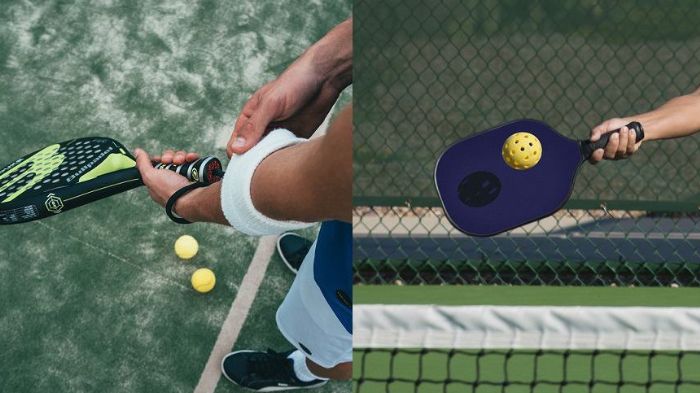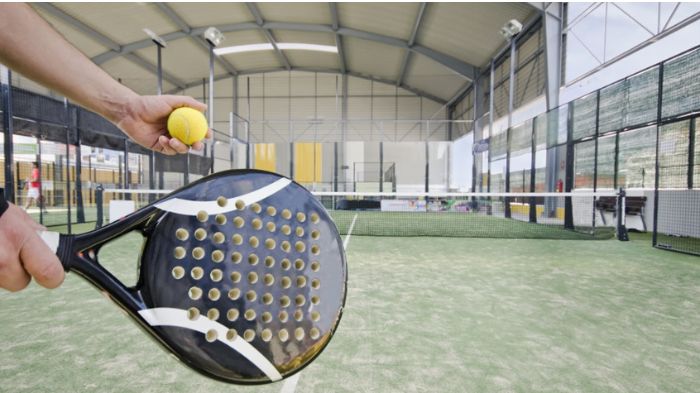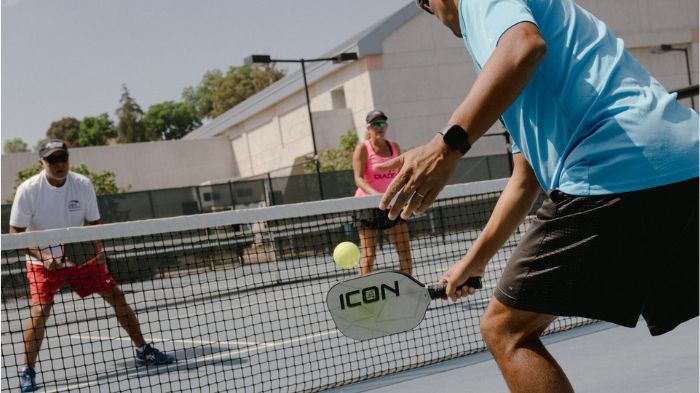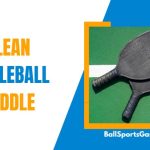Happy day! Do you want to discover the distinctions between pickleball and paddle tennis? It is understandable why these two paddle sports have suddenly gained so much popularity. They each offer a distinctive and exciting way to have fun while being active.
This article will go through the specifics of pickleball and paddle tennis, such as court dimensions, necessary gear, and even the laws of the games.
Whether you’re a novice looking to try a new sport or an experienced athlete looking to switch things up, we have options for you. So let’s get going and discover the worlds of pickleball and paddle tennis together.

What is Pickleball and Paddle Tennis?
Both are paddle sports and are played on the court but there is a slight difference in both of the games. Both are between tennis and badminton, bigger than badminton and shorter than tennis. Let’s see what they are.
Pickleball
The inspiration for pickleball comes from a variety of well-known sports, including tennis, badminton, and table tennis. Pickleball is a unique and exciting paddle activity. Because it is played on a smaller court, players of all ages and fitness levels can participate in this exciting game.
Players compete in frantic rallies that put their talent, accuracy, and strategic thinking to the test using a sturdy paddle and a plastic ball with holes. Pickleball is a sport that can be played both inside and outside and provides a beautiful balance of rivalry, camaraderie, and exercise.
Paddle Tennis
Originating in the vibrant streets of New York City during the early 20th century, paddle tennis has established itself as a thrilling paddle sport with a rich history.
Played on a slightly larger court compared to pickleball, paddle tennis requires a solid paddle and a depressurized tennis ball. It combines elements from traditional tennis and platform tennis, resulting in a unique gameplay experience.
Paddle tennis is predominantly played outdoors, where players showcase their quick reflexes, swift movements, and tactical shot placement. The sport’s fast-paced nature keeps participants engaged, promoting a healthy dose of competition and physical exertion.
Types of Paddleball
When it comes to paddleball, there are two main types: one-wall paddleball and four-wall paddleball. Let’s take a closer look at each of these variations.

One-Wall Paddleball:
As the name suggests, one-wall paddleball is played against a single wall. This type of paddleball is typically played outdoors, with players hitting the ball against a wall that serves as the back boundary of the court.
The objective is to keep the ball in play by hitting it against the wall, while opponents try to return it before it bounces twice. One-wall paddleball is known for its fast-paced and intense gameplay, requiring quick reflexes and strategic shot placement.
Four-Wall Paddleball:
Four-wall paddleball, on the other hand, is played in a court that is encircled by four walls. This kind of paddle ball may be played both inside and outside, providing a regulated setting for rivalry.
The four boundaries create a more organized court, enabling a range of game-playing positions and shots. The versatility of four-wall paddleball is well known, and it is often played at all skill levels, from leisure play to the highest levels of competition.
Playing paddleball against a single wall or against four walls offers varied challenges and opportunities. Compared to one-wall paddleball, which is typically associated with outdoor recreational play, four-wall paddleball offers a more organized and competitive environment.
Regardless of the variety you select, paddleball is an exhilarating activity that combines skill, strategy, and physical conditioning and provides hours of fun and excitement for players of all ages and skill levels.
Difference Between Pickleball vs Paddle Tennis
Certainly! Here’s a comparison table highlighting the differences between pickleball and paddle tennis:
| Aspect | Pickleball | Paddle Tennis |
|---|---|---|
| Court Size | Smaller: 20 ft x 44 ft | Larger: 10 m x 20 m |
| Net | Standard height | Varied height (center vs. sides) |
| Equipment | Paddle and plastic ball | Paddle and depressurized tennis ball |
| Serve Technique | Underhand | Overhand |
| Ball Bouncing | Double bounce required | Optional, can be volleyed without bounce |
| Scoring | Points awarded on every serve | Points are awarded on every serve |
Please note that while both sports have similarities, these differences in court size, equipment, rules, and gameplay contribute to unique experiences and strategies in each sport.
Court Size: One of the main differences between pickleball and paddle tennis is the court size. Pickleball is played on a smaller court, typically measuring 20 feet wide and 44 feet long for doubles play.
In paddle tennis, the court is a rectangular area enclosed by walls, measuring 10 meters wide and 20 meters long. The net divides the court, rising to 88 cm at the center and 92 cm at the sides.
The back wall stands 3 meters high and has the same width as the sidewalls. The service line is positioned 3 meters before the back wall, determining where players must serve the ball. These elements contribute to the dynamics and strategic nature of paddle tennis.
Paddle and Ball: Another distinction lies in the equipment used. In pickleball, players use a solid paddle of composite materials or wood and a plastic ball with holes.
Paddle tennis players, on the other hand, use a solid paddle made of various materials, such as graphite or carbon fiber, and a depressurized tennis ball.
Rules and Gameplay: The rules and gameplay of pickleball and paddle tennis also differ. In pickleball, the serve must be hit underhand and diagonally across the net, and the ball must bounce once on each side before players can volley it.
Paddle tennis follows similar rules, with players serving overhand and having the option to volley the ball without letting it bounce.
Similarities Between The Sports
Despite their differences, pickleball and paddle tennis also share some similarities. Both sports are played with paddles and require players to hit a ball over a net. They emphasize hand-eye coordination, quick reflexes, and strategic shot placement.

| Aspect | Pickleball | Paddle Tennis |
|---|---|---|
| Sport Type | Paddle Sport | Paddle Sport |
| Court Size | Smaller than a traditional tennis court | Points are awarded for successful shots over the net |
| Net | Divides the court into two halves | Divides the court into two halves |
| Scoring | Points awarded for successful shots over the net | Points are awarded for successful shots over the net |
| Hand-Eye Coordination | Required for accurate shots and quick reactions | Required for accurate shots and quick reactions |
| Social Aspect | Fosters community engagement and recreational play | Fosters community engagement and recreational play |
Pickleball and paddle tennis, while distinct in their own ways, share several similarities that make them appealing paddle sports for enthusiasts.
- Paddle Sports: Both pickleball and paddle tennis fall under the category of paddle sports, which involve the use of solid paddles to hit a ball over a net. This similarity in equipment creates a familiar playing experience and allows players to transition easily between the two sports.
- Court Dimensions: Both sports are played on a court that is smaller than a traditional tennis court. While the exact dimensions may vary, pickleball and paddle tennis courts are designed to accommodate the smaller playing area, providing more intimate and fast-paced gameplay.
- Net and Scoring: Both sports utilize a net that divides the court into two halves. Players must hit the ball over the net and aim to land it within the opponent’s court to score points. The scoring system is similar, where points are awarded when the opposing team fails to return the ball successfully.
- Hand-Eye Coordination: Pickleball and paddle tennis require excellent hand-eye coordination to strike the ball accurately and respond to opponents’ shots effectively. Both sports challenge players to anticipate the trajectory and speed of the ball, making split-second decisions and executing precise shots.
- Social and Recreational Aspects: Both pickleball and paddle tennis fosters a social and recreational environment. These sports are popular among players of all ages and skill levels, providing opportunities for friendly competition, community engagement, and physical activity.
Additionally, both sports can be enjoyed by people of various ages and fitness levels, making them accessible and inclusive.
Which Is The Better Sport?
Determining which sport is better, pickleball or paddle tennis ultimately depends on personal preferences and goals. Pickleball is known for its social and inclusive nature, making it a great choice for those looking for a fun and engaging activity that can be enjoyed with friends and family.
Paddle tennis, on the other hand, offers a more traditional tennis-like experience with a faster pace and larger court size.
Ultimately, the better sport is the one that aligns with your interests, fitness level, and the kind of experience you’re seeking.
Pickleball might be the ideal choice if you enjoy a slower-paced game with a focus on strategy and accuracy. Paddle tennis might be more suitable if you prefer a faster-paced sport with a traditional tennis feel.
FAQs
Pickleball is played on a smaller court with a solid paddle and a plastic ball with holes, while paddle tennis is played on a larger court with a solid paddle and a depressurized tennis ball. The court size, equipment used, and gameplay rules vary between the two sports.
While pickleball can be played on a paddle tennis court, it requires additional court markings and a different net height. Paddle tennis courts are typically larger and have higher nets compared to pickleball courts.
Both pickleball and paddle tennis can be enjoyed by beginners, but pickleball is often considered more beginner-friendly due to its smaller court size, slower pace, and easier learning curve. Paddle tennis requires more agility and power, making it slightly more challenging for beginners.
Both pickleball and paddle tennis can be played at recreational or competitive levels. However, paddle tennis is often considered more competitive due to its faster pace and strategic gameplay. Pickleball can also be competitive, but it offers a wider range of skill levels and is generally more accessible to players of all ages and abilities.
Conclusion
In conclusion, both pickleball and paddle tennis offer unique experiences and can be enjoyed by individuals seeking an active and enjoyable paddle sport.
Exploring both sports and finding the one that resonates with you will ensure that you have a great time on the court while reaping the numerous physical and social benefits they provide. So grab a paddle, hit the court, and discover the joy of pickleball or paddle tennis for yourself!



